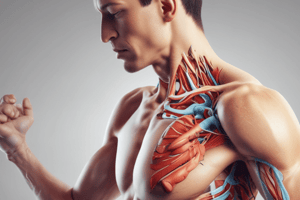Podcast
Questions and Answers
What is a key characteristic of the initial phase of Adhesive Capsulitis?
What is a key characteristic of the initial phase of Adhesive Capsulitis?
- Pain with gradual range of motion loss
- Pain at night and difficulty sleeping (correct)
- Normal muscle performance
- Substantial range of motion deficits
Which outcome measure is specifically validated for Adhesive Capsulitis?
Which outcome measure is specifically validated for Adhesive Capsulitis?
- Penn Shoulder Scale (PSS)
- Shoulder Pain and Disability Index (SPADI) (correct)
- Patient Specific Functional Scale (PSFS)
- QuickDASH
What intervention has Level A Evidence for Adhesive Capsulitis?
What intervention has Level A Evidence for Adhesive Capsulitis?
- Stretching Exercises
- Corticosteroid Injection (correct)
- Patient Education
- Joint Mobilizations
What is a key consideration when looking to rule-in Osteoarthritis?
What is a key consideration when looking to rule-in Osteoarthritis?
What is a key characteristic of the frozen phase of Adhesive Capsulitis?
What is a key characteristic of the frozen phase of Adhesive Capsulitis?
What is a key aspect of the intervention focus for Adhesive Capsulitis?
What is a key aspect of the intervention focus for Adhesive Capsulitis?
What is a potential objective information for AC joint separation?
What is a potential objective information for AC joint separation?
Which special test is relevant for AC joint separation?
Which special test is relevant for AC joint separation?
Which grade of shoulder separation involves complete tearing of acromioclavicular and coracoclavicular ligaments?
Which grade of shoulder separation involves complete tearing of acromioclavicular and coracoclavicular ligaments?
What is a potential intervention focus for AC joint separation?
What is a potential intervention focus for AC joint separation?
What type of pain is commonly associated with AC joint separation during shoulder movements?
What type of pain is commonly associated with AC joint separation during shoulder movements?
Which diagnostic tool is recommended for Glenohumeral Osteoarthritis (GHOA)?
Which diagnostic tool is recommended for Glenohumeral Osteoarthritis (GHOA)?
How are Stages of RTC Tendinopathy categorized?
How are Stages of RTC Tendinopathy categorized?
What may Labral Injuries (SLAP Tears) be categorized based on?
What may Labral Injuries (SLAP Tears) be categorized based on?
What may be a potential objective information for Glenohumeral Instability?
What may be a potential objective information for Glenohumeral Instability?
Flashcards are hidden until you start studying
Study Notes
Shoulder Injury Assessment and Treatment
- For Glenohumeral Osteoarthritis (GHOA), key symptoms include stiffness in the morning, pain with activity, and decreased joint mobility.
- MRI is the recommended diagnostic tool for GHOA, and interventions may include physical therapy, medication, injections, and surgery.
- Rotator Cuff Tendinopathy (RTC) may present with pain at the top and lateral aspect of the shoulder, weakness, and a history of repetitive overhead activity.
- Stages of RTC Tendinopathy include inflammation, partial tearing, and full tear, with symptoms such as painful arc of movement and weakness.
- Treatment for RTC Tendinopathy may involve physical therapy to improve tissue tolerance and force production, as well as medical interventions like anti-inflammatories and corticosteroid injections.
- Labral Injuries (SLAP Tears) can occur in throwing athletes or due to forceful arm traction, with different types categorized based on the extent of the tear and biceps tendon involvement.
- Symptoms of SLAP Tears include decreased overhead range of motion, pain with cross body movements, and decreased dynamic mobility control.
- There is no current clinical practice guideline (CPG) for SLAP Tears, and interventions may focus on physical therapy to improve muscle coordination and activation, normalize movement, and reduce tissue stress.
- For Glenohumeral Instability, potential diagnoses should consider sudden onset of symptoms, participation in contact sports, and generalized joint hypermobility.
- Objective information for Glenohumeral Instability may include decreased joint mobility and muscle performance, and special tests like the Biceps Load Test.
- Interventions for Glenohumeral Instability may involve physical therapy and medical interventions, with surgical repair for severe cases.
- Outcome measures for all shoulder injuries may include the Patient Specific Functional Scale (PSFS), QuickDASH, Penn Shoulder Scale (PSS), and Shoulder Pain and Disability Index (SPADI).
Studying That Suits You
Use AI to generate personalized quizzes and flashcards to suit your learning preferences.




